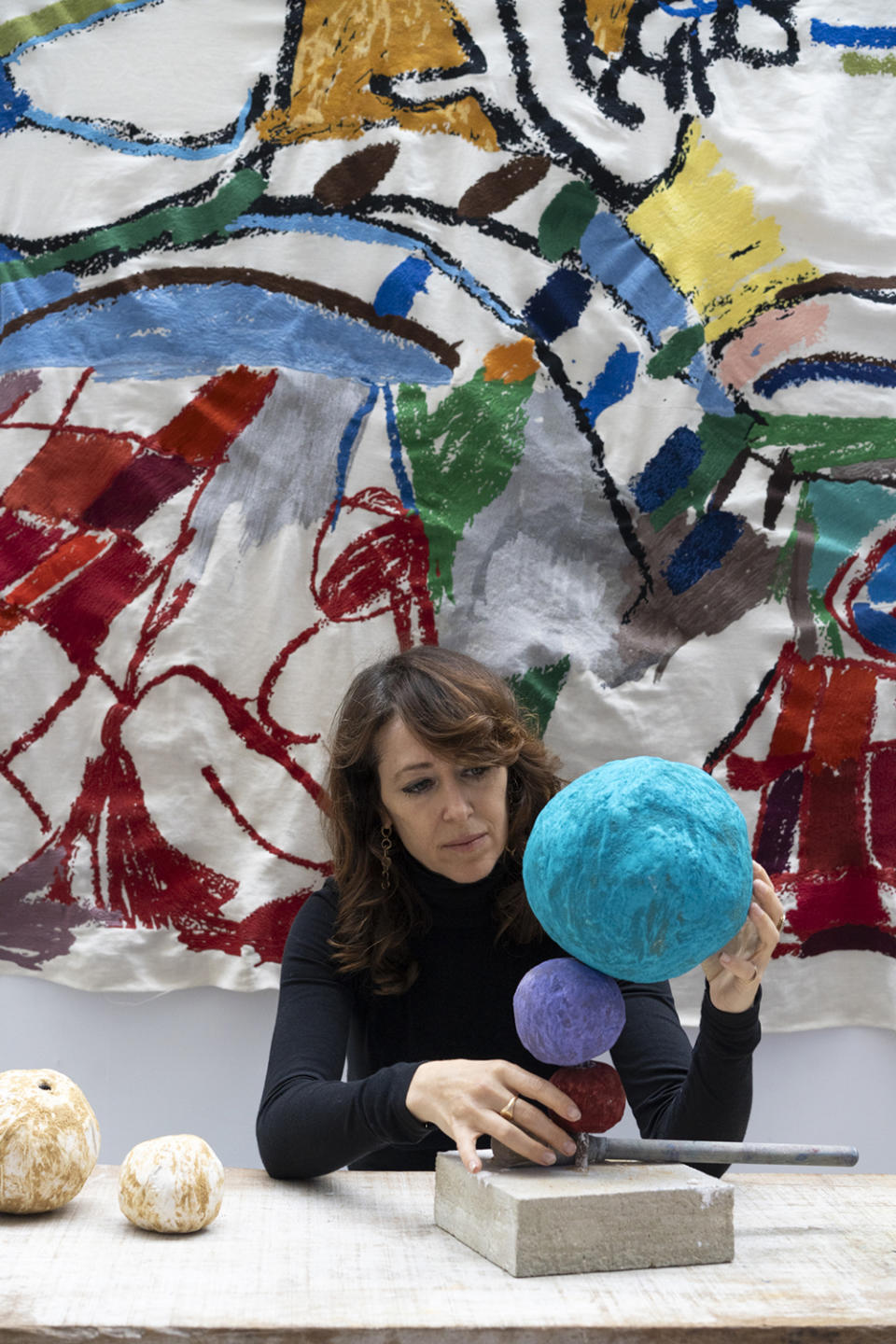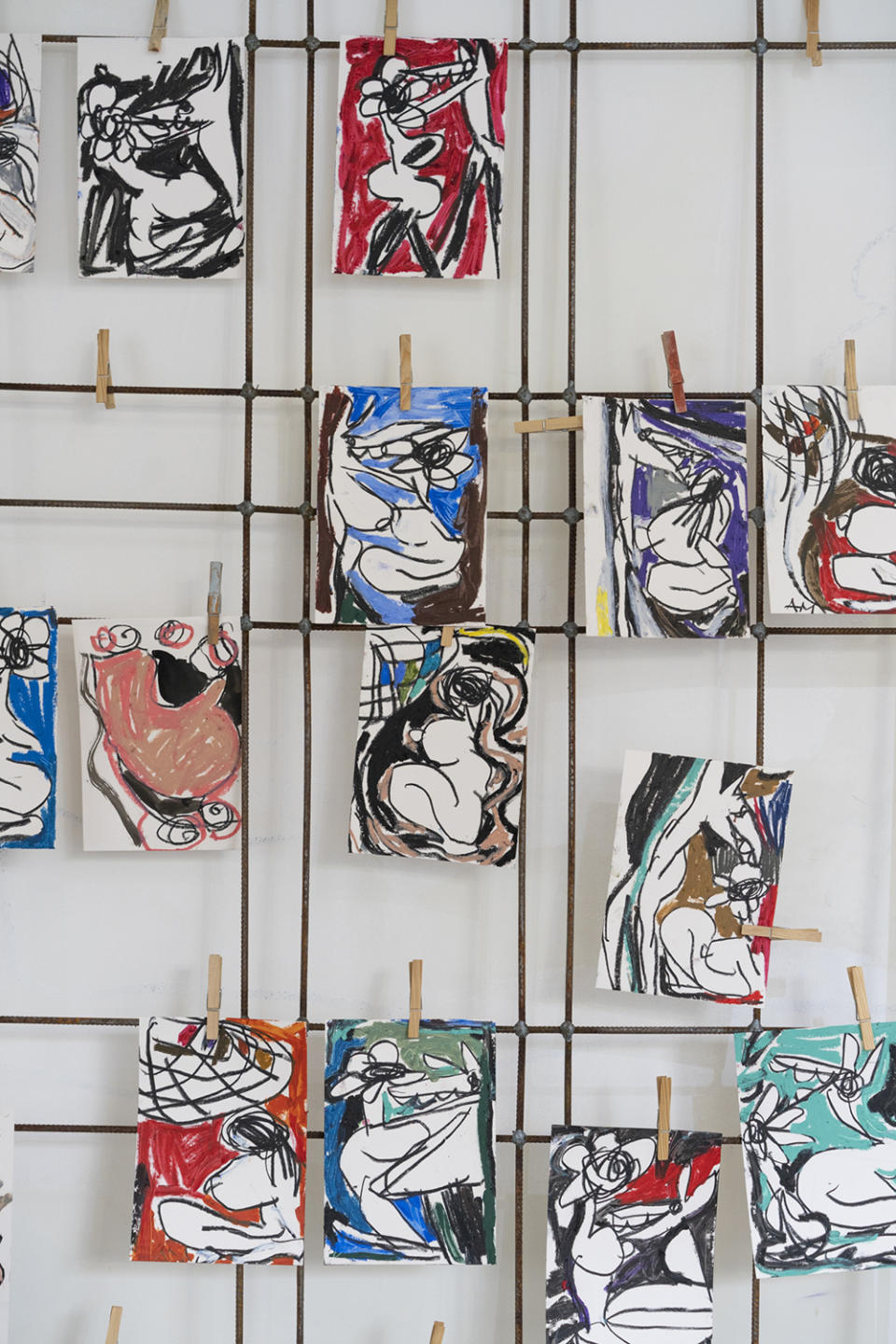How Artist Annie Morris Brings Her Whimsical Sculptures and Drawings to Life

- Oops!Something went wrong.Please try again later.
- Oops!Something went wrong.Please try again later.
Annie Morris is talking a mile a minute over Zoom, routinely interrupting herself mid-sentence, or even mid-word, as she paces nonstop through her East London studio. “I never sit down,” she admits, holding her phone aloft.
Her husband, artist Idris Khan, whose studio occupies the same former toy-factory building as hers, pops into the screen and vouches for her ambulatory habit. “People follow her around the studio,” he says.
More from Robb Report
A London Townhouse Once Owned by the Manager of The Beatles Just Listed for $10.6 Million
This $9.7 Million London Apartment Was Designed to Showcase Fine Art
The Former London Home of Sex Pistols' Johnny Rotten Hits Market For $2 Million
That space is now a forest of richly hued plaster sculptures, the latest in Morris’s long-running series of totemic towers of misshapen spheres she calls “Stacks.” The orbs appear to teeter on top of one another in ways that defy physics (a hidden steel pole impaling the pieces enables that bit of magic). “It’s a really, really busy studio—I can barely walk around,” she says. “And I have to clear some space, because I’m going to be doing some drawings.” Somehow, though, she finds the workshop has “a nice calm to it.”
Morris is probably well served by her inability to sit still: When we speak, she’s preparing for multiple shows, among them a solo outing opening November 2 at Timothy Taylor gallery in New York, another at the Fosun Museum in Shanghai next spring, and a Khan-Morris two-person exhibition that traveled from Newlands House in Petworth to the Pitzhanger Manor & Gallery in London, where it will be on view through January 7. Meanwhile, the couple are in the final stages of renovating a new home for themselves and their two young children—the former residence of Oscar Wilde’s lover Lord Alfred Douglas as well as of the artist William Rothenstein.
Morris’s “Stacks” have always occupied the liminal space between sculpture and painting that has interested her since her art-school days. “For me, they’re really like paintings, but they’re not on canvas,” she says. They have evolved considerably, though, since she began making them about a decade ago. For one thing, whereas the initial works were tall and thin, these new ones are stout.

But one constant is the central role of drawing in her practice, whether in the studio or at home and with implements as disparate as Sharpies, highlighters, and oil sticks. “I often draw after everyone goes to sleep because I love drawing at night,” she says. “It’s one of my favorite things to do.” The drawings can be stand-alone works, but a breast in an abstracted figure, say, might also inspire a sphere in a “Stack.” Morris makes what she calls tapestries by drawing, reconfiguring, and sewing compositions together; the embroidery thread mimics scribbles and adds a subtle dimension.
A “Stack” starts with a watercolor drawing. Then, in a satellite studio on the same street, Morris carves scores of spheres from dense foam. Back in her main studio, she coats the objects with plaster and paints them with layers of sand and raw pigment; the sand, in varying degrees of coarseness, concentrates dollops of saturated pigment in places, giving the pieces yet more texture and an otherworldly vibe. At this stage, she allows herself the freedom to abandon the schematic and improvise, sliding various small boulders on and off the rods until she’s satisfied with an arrangement.
There’s a Seussian whimsy to the “Stacks,” a resemblance to a child’s Play-Doh creation. But the oeuvre’s genesis was grief, not joy. “I began this series in a very traumatic time in my life, when we lost our first child,” Morris recalls. “I was obsessing over the shape that I’d lost.”
Morris found herself repeatedly drawing ovoids that alluded both to eggs and to the swollen belly of her pregnancy. Piling these rounded pieces on top of one another in three dimensions compounded the sense of fragility, or impending doom. “There’s the feeling that you couldn’t and shouldn’t stack a sculpture in this way, and they should all fall,” she says. “There was something so lovely to me about the poetry of it. And even though they came from this enormous loss, for me, they’re very much about remembering someone. It’s about keeping that something alive that was such a big part of my life.” Which may be why she feels a sad void whenever the finished works leave the studio.

Morris is one of those artists who knew their destiny from early childhood: An indifferent student, she could happily draw for hours straight. After graduating from London’s elite Westminster School, she studied under the great Italian sculptor Giuseppe Penone at the École des Beaux-Arts in Paris and credits him with teaching her that a work should embody a sense of mystery.
While still a student, Morris landed a gig as the “entertainment” at a bar in the Bastille. As patrons drank and watched, she executed compositions on enormous sheets of paper taped to the wall. “And I could keep the drawings!” she exclaims.
Morris has since dispensed with the paper at times, drawing directly on walls, as she did all over the family’s farmhouse in southwestern France. (It was good training for another recent project: the Painter’s Room, an intimate bar at Claridge’s, where she made monochromatic, childlike murals above the elegant banquettes and created a showstopping stained-glass window as the focal point.) Morris cops to tinkering with the farmhouse’s doodles every time she visits.
Which may point to another reason she incessantly roves among her works in the studio: She never feels quite finished. “Even when I’m talking to you, I’ve got one eye on the sculptures,” Morris admits. “I’ve now realized what I want to do to one when I get the opportunity.”
Best of Robb Report
Sign up for Robb Report's Newsletter. For the latest news, follow us on Facebook, Twitter, and Instagram.

